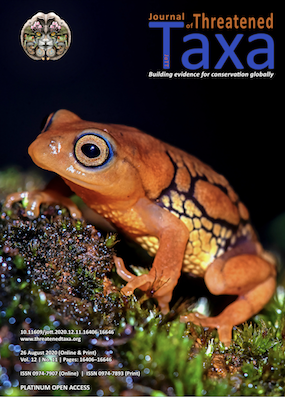Evaluating threats and conservation status of South African Aloe
Main Article Content
Abstract
South Africa is one of the biodiversity hotspots for Aloe in Africa. This makes it important to evaluate the conservation status and threats to this genus. The South African National Biodiversity Institute (SANBI) Red List was employed to evaluate these two factors. Results revealed that 44% of all species in this genus are of conservation concern with the majority of them facing threats. This study recommends that more attention such as strengthening the protection of these species and controlling the threats identified in this study should be given to species in this genus in terms of conservation management to reduce their risk of extinction.
Article Details
Authors own the copyright to the articles published in JoTT. This is indicated explicitly in each publication. The authors grant permission to the publisher Wildlife Information Liaison Development (WILD) Society to publish the article in the Journal of Threatened Taxa. The authors recognize WILD as the original publisher, and to sell hard copies of the Journal and article to any buyer. JoTT is registered under the Creative Commons Attribution 4.0 International License (CC BY), which allows authors to retain copyright ownership. Under this license the authors allow anyone to download, cite, use the data, modify, reprint, copy and distribute provided the authors and source of publication are credited through appropriate citations (e.g., Son et al. (2016). Bats (Mammalia: Chiroptera) of the southeastern Truong Son Mountains, Quang Ngai Province, Vietnam. Journal of Threatened Taxa 8(7): 8953–8969. https://doi.org/10.11609/jott.2785.8.7.8953-8969). Users of the data do not require specific permission from the authors or the publisher.
References
Bamigboye, S.O. (2019). Conservation status and threats to endemic plant species of Griqualand West of South Africa. Journal of Plant Development 26: 117–121. https://doi.org/10.33628/jpd.2019.26.1.11
Bamigboye, S.O., P.M. Tshisikhawe & P.J. Taylor (2016). Review of extinction risk in African cycads. Phyton International Journal of Experimental Botany 85(1): 333–336.
Bjorå, C.S., E. Wabuyele, O.M. Grace, I. Nordal & L.E. Newton (2015). The uses of Kenyan aloes: an analysis of implications for names, distribution and conservation. Journal of Ethnobiology and Ethnomedicine 11: 82. https://doi.org/10.1186/s13002-015-0060-0 DOI: https://doi.org/10.1186/s13002-015-0060-0
Botes, C., S.D. Johnson & R.M. Cowling (2009a). The birds and the bees: Using selective exclusion to identify effective pollinators of African tree aloes. International Journal of Plant Science 170 (2): 151–156. https://doi.org/10.1086/595291 DOI: https://doi.org/10.1086/595291
Botes, C., P.D. Wragg & S.D. Johnson (2009b). New evidence for bee-pollination systems in Aloe (Asphodelaceae: Aloideae), a predominantly bird-pollinated genus. South African Journal of Botany 75: 675–681. https://doi.org/10.1016/j.sajb.2009.07.010 DOI: https://doi.org/10.1016/j.sajb.2009.07.010
Cousins, S.R. & E.T.F. Witkowski (2012). African Aloe Ecology: A Review. Journal of Arid Environments 85: 1–17. https://doi.org/10.1016/j.jaridenv.2012.03.022 DOI: https://doi.org/10.1016/j.jaridenv.2012.03.022
Forbes, R.W., A.J.F.K. Craig, P.E. Hulley & D.M. Parker (2009). Seasonal variation in the avian community associated with an Aloe ferox (Asphodelaceae, Mill.) flowering event in the Eastern Cape, South Africa. In: Harebottle D.M., A.J.F.K. Craig, M.D. Anderson, H. Rakotomanana & M. Muchai (eds.). Proceedings of the 12th Pan-African Ornithological Congress, 2008, Cape Town.
Grace, O.M. (2009). Systematics and biocultural value of Aloe L. (Asphodelaceae). PhD Thesis. University of Pretoria, 158pp.
Grace, O.M. (2011). Current perspectives on the economic botany of the genus Aloe Xanthorrhoeaceae. South African Journal of Botany 98: 980–987. https://doi.org/10.1016/j.sajb.2011.07.002 DOI: https://doi.org/10.1016/j.sajb.2011.07.002
Grace, O.M., M.S.J. Simmond, G.F. Smith & A.E. van Wyk (2009). Documented utility and biocultural value of Aloe L. (Asphodelaceae): a review. Economic Botany 63(2): 167–178. https://doi.org/10.1007/s12231-009-9082-7 DOI: https://doi.org/10.1007/s12231-009-9082-7
Grace, O.M., S. Buerki, M.R. Symonds, F. Forest, A.E. van Wyk, G.F. Smith, R.R. Klopper, C.S. Bjorå, S. Neale, S. Demissew, M.S.J. Simmonds & N. Rønsted (2015). Evolutionary history and leaf succulence as explanations for medicinal use in aloes and the global popularity of Aloe vera. BMC Evolutionary Biology 15: 29. https://doi.org/10.1186/s12862-015-0291-7 DOI: https://doi.org/10.1186/s12862-015-0291-7
Klopper R.R. & G.F. Smith (2013). Aloes of the world: When, where and who? Aloe 50 (1&2): 44–52.
Moraswi I., S.O. Bamigboye & P.M. Tshisikhawe (2019). Conservation status and threats to vascular plant species endemic to Soutpansberg Mountain in Limpopo Province, South Africa. International Journal of Plant Biology. 10: 7978: 14–16. https://doi.org/10.4081/pb.2019.7978 DOI: https://doi.org/10.4081/pb.2019.7978
Nicolson, S.W. & M. Nepi (2005). Dilute nectar in dry atmospheres: nectar secretion patterns in Aloe castanea (Asphodelaceae). International Journal of Plant Sciences 166(2): 227–233. https://doi.org/10.1086/427616 DOI: https://doi.org/10.1086/427616
Smith, G.F. & B. van Wyk (2009). Aloes in Southern Africa. Struik Nature, Cape Town.
South African National Biodiversity Institute (SANBI) National Red List version for genus Aloe (2017). http://redlist.sanbi.org/genus.php?genus=2206.
Symes, C.T., S.W. Nicholson & A.E. McKechnie (2008). Response of avian nectarivores to the flowering of Aloe marlothii: a nectar oasis during dry South African winters. Journal of Ornithology 149: 13–22. https://doi.org/10.1007/s10336-007-0206-5 DOI: https://doi.org/10.1007/s10336-007-0206-5
Wabuyele, E. & S. Kyalo (2008). Sustainable Use of East African Aloes: the Case of Commercial Aloes in Kenya. NDF Workshop Case Studies, WG3 e Succulents and Cycads, Case Study 1: Aloe spp. East and southern Africa, Mexico, 17pp.
Williams, V.L., J.E. Victor & N.R. Crouch (2013). Red listed medicinal plants of South Africa: status, trend and assessment challenges. South African Journal of Botany 86: 23–35. https://doi.org/10.1016/j.sajb.2013.01.006 DOI: https://doi.org/10.1016/j.sajb.2013.01.006
Victor, J.E. & M. Keith (2004). The orange list: a safety net for biodiversity in South Africa South African Journal of Science 100: 139–141.

